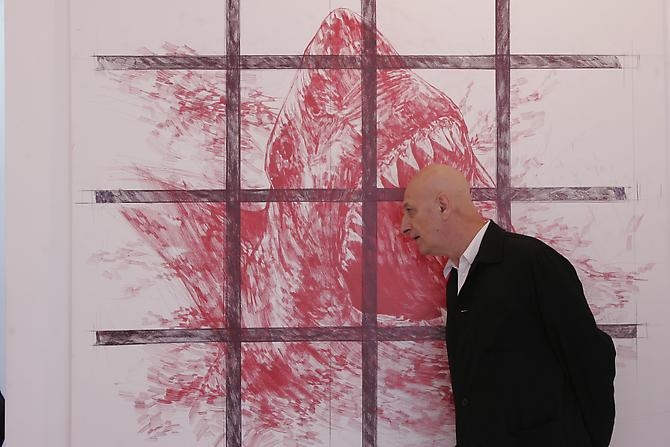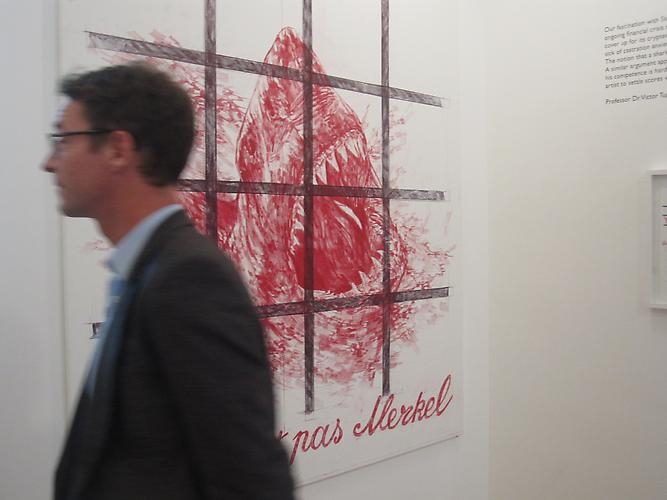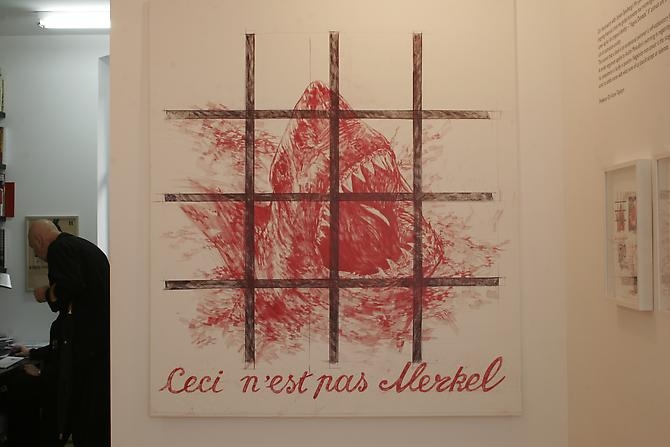ROSTA x MOLODKIN
Russian Avant-Garde x Andrei Molodkin
September 5th – October 27th, 2009
In this exhibition, political avant-garde art from the former Soviet Union rubs shoulders with the current political works of Russian artist Andrei Molodkin. The latter attained international recognition in recent years owing to his politically motivated crude oil sculptures and large-scale ballpoint pen drawings and is currently representing Russia at the Venice Biennale.
The exhibition will feature hand-painted Russian avant-garde posters – known as ‘Rosta windows’ – which were produced during a time of internal and external upheaval. The Rosta windows are the first Soviet propaganda posters published by the Russian telegraph agency ‘Rosta’ between September 1919 and February 1922 under the supervision of Vladimir Mayakovsky.
A new ballpoint pen work by Andrei Molodkin (born 1966) will also be on display.
The Rosta windows dealt with political, military and economic themes and were displayed in the shop windows of Moscow. Rather than printed posters in the conventional sense, they were hand-painted by some of the most prominent Russian avant-garde artists of the time.
Vladimir Mayakovsky was one of the first Russian artists to devote themselves to the revolution and one of the most committed to it. He saw the political and artistic revolution in the years following 1917 as being one inextricable unit. Mayakovsky described the Rosta windows as “a nation of 150 million being served by hand by a small group of painters”. He was responsible for creating roughly 9/10 of the texts. He was also instrumental in shaping the bold, stark-coloured, laconic yet dynamic forms used in the funny, but often grotesque and folksy drawings in a marriage of political potency and modern imagery.
In its latest exhibition, Galerie Priska Pasquer juxtaposes these outstanding political posters with a new ballpoint pen work by Russian artist Andrei Molodkin.
It was during his time as a soldier that Andrei Molodkin began his ballpoint pen drawings, which have a predominantly political focus. In this work – ‘Ceci n’est pas Merkel’ – Molodkin plays with an image of the ‘financial shark’ used by German left-of-centre party SPD for its election poster campaign in spring 2009, with a definite nod to a painting of Belgian surrealist René Magritte.
The exhibition also features vintage photography by Alexander Rodchenko, one of the protagonists of Russian Modernism.
Before Rodchenko adopted the medium of photography in the mid-1920s, he had already made a name for himself in Moscow as a versatile and innovative artist.
Rodchenko’s approach to photography was a radical departure from the art photography that held sway at the turn of the century. The aim was to revolutionise the perspective of photography, offering a “new perspective” that would change society and people – in a time of epoch-making changes in Russia and Europe alike.
QUOTATION
The last series of the ROSTA posters was issued at the time when the Constructivists defied easel painting and committed themselves to production art. Thus the ROSTA collective, with the poet and artist Vladimir Mayakovsky on board, contributed to the new phase of the Russian avant-garde that guarded art from succumbing to the level of mere commodity. Success-fully advanced by the post-war neo-avant-garde artists, this paradigm of socially conscious aesthetics has fallen — under the pressure of today’s narcissistic individualism — into the category of endangered species. Andrei Molodkin’s ballpoint drawings that pulsate with the muscle power of “the artist as producer,” resuscitate the productivist model of art making; this time he renders a dichotomous image of a bloody shark reminding us that this mode of production is simultaneously powerful and vulnerable.
Dr. Margarita Tupitsyn
QUOTATION
Our fascination with Steven Spielberg’s film Jaws (1975) hints at the possibility that at the time of the ongoing financial crisis the global economy has misrecognized itself for a shark or used this image as a cover up for its crypted identity – “Vagina Dentata.” If “animals are sick of surplus value,” men must be sick of castration anxiety.
The notion that a shark is an exceptional swimmer is self-explanatory because it lives in water. A similar argument applies to Andrei Molodkin’s swimming in negativity. For as long as he stays there, his competence is hardly in question. Negativity mon amour is the slogan of today, for it prompts the artist to settle scores with what none of us should accept or tolerate.
Professor Dr. Victor Tupitsyn
In this exhibition, political avant-garde art from the former Soviet Union rubs shoulders with the current political works of Russian artist Andrei Molodkin. The latter attained international recognition in recent years owing to his politically motivated crude oil sculptures and large-scale ballpoint pen drawings and is currently representing Russia at the Venice Biennale.
The exhibition will feature hand-painted Russian avant-garde posters – known as ‘Rosta windows’ – which were produced during a time of internal and external upheaval. The Rosta windows are the first Soviet propaganda posters published by the Russian telegraph agency ‘Rosta’ between September 1919 and February 1922 under the supervision of Vladimir Mayakovsky.
A new ballpoint pen work by Andrei Molodkin (born 1966) will also be on display.
The Rosta windows dealt with political, military and economic themes and were displayed in the shop windows of Moscow. Rather than printed posters in the conventional sense, they were hand-painted by some of the most prominent Russian avant-garde artists of the time.
Vladimir Mayakovsky was one of the first Russian artists to devote themselves to the revolution and one of the most committed to it. He saw the political and artistic revolution in the years following 1917 as being one inextricable unit. Mayakovsky described the Rosta windows as “a nation of 150 million being served by hand by a small group of painters”. He was responsible for creating roughly 9/10 of the texts. He was also instrumental in shaping the bold, stark-coloured, laconic yet dynamic forms used in the funny, but often grotesque and folksy drawings in a marriage of political potency and modern imagery.
In its latest exhibition, Galerie Priska Pasquer juxtaposes these outstanding political posters with a new ballpoint pen work by Russian artist Andrei Molodkin.
It was during his time as a soldier that Andrei Molodkin began his ballpoint pen drawings, which have a predominantly political focus. In this work – ‘Ceci n’est pas Merkel’ – Molodkin plays with an image of the ‘financial shark’ used by German left-of-centre party SPD for its election poster campaign in spring 2009, with a definite nod to a painting of Belgian surrealist René Magritte.
The exhibition also features vintage photography by Alexander Rodchenko, one of the protagonists of Russian Modernism.
Before Rodchenko adopted the medium of photography in the mid-1920s, he had already made a name for himself in Moscow as a versatile and innovative artist.
Rodchenko’s approach to photography was a radical departure from the art photography that held sway at the turn of the century. The aim was to revolutionise the perspective of photography, offering a “new perspective” that would change society and people – in a time of epoch-making changes in Russia and Europe alike.
QUOTATION
The last series of the ROSTA posters was issued at the time when the Constructivists defied easel painting and committed themselves to production art. Thus the ROSTA collective, with the poet and artist Vladimir Mayakovsky on board, contributed to the new phase of the Russian avant-garde that guarded art from succumbing to the level of mere commodity. Success-fully advanced by the post-war neo-avant-garde artists, this paradigm of socially conscious aesthetics has fallen — under the pressure of today’s narcissistic individualism — into the category of endangered species. Andrei Molodkin’s ballpoint drawings that pulsate with the muscle power of “the artist as producer,” resuscitate the productivist model of art making; this time he renders a dichotomous image of a bloody shark reminding us that this mode of production is simultaneously powerful and vulnerable.
Dr. Margarita Tupitsyn
QUOTATION
Our fascination with Steven Spielberg’s film Jaws (1975) hints at the possibility that at the time of the ongoing financial crisis the global economy has misrecognized itself for a shark or used this image as a cover up for its crypted identity – “Vagina Dentata.” If “animals are sick of surplus value,” men must be sick of castration anxiety.
The notion that a shark is an exceptional swimmer is self-explanatory because it lives in water. A similar argument applies to Andrei Molodkin’s swimming in negativity. For as long as he stays there, his competence is hardly in question. Negativity mon amour is the slogan of today, for it prompts the artist to settle scores with what none of us should accept or tolerate.
Professor Dr. Victor Tupitsyn










